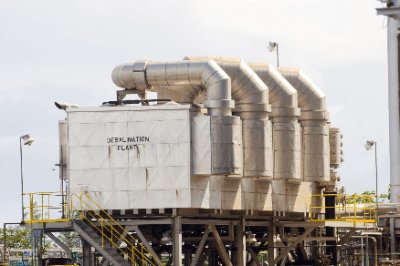What Is a Seawater Filtration Device?
 Seawater filtration devices are used to desalinate seawater by desalinating the sodium chloride contained in seawater through filtration.
Seawater filtration devices are used to desalinate seawater by desalinating the sodium chloride contained in seawater through filtration.
Desalination of seawater has been practiced for a long time, but in many cases, seawater was treated by evaporation, which required enormous energy and cost. The development of seawater filtration devices, however, has completely changed the situation.
Seawater filtration devices use reverse osmosis membranes in a system based on the principle of osmotic pressure to perform desalination. The system has already been introduced in countries with scarce water resources, such as the Middle East and Africa.
Uses of Seawater Filtration Devices
The main application of seawater filtration devices is to desalinate seawater. They are being introduced in countries and regions where water resources are scarce. Japan has abundant water resources, so there are few examples of its introduction.
However, the technology of Japanese companies is among the best in the world and has been introduced in many overseas countries. Especially in arid regions, people are suffering from severe water shortages, and securing water for daily use has become an urgent issue. In addition, there are concerns about the shortage of water resources due to population growth, and demand is expected to grow not only in arid regions but also in other countries around the world in the future.
Principle of Seawater Filtration Devices
Seawater is abundant throughout the world, but it cannot be used as domestic water. This is because it contains salt, or sodium chloride. Seawater filtration devices are equipped with reverse osmosis membranes, which remove sodium chloride through filtration using osmotic pressure.
When solutions of different concentrations are separated by osmotic membranes, water moves from a solution of lower concentration to a solution of higher concentration in order to keep the concentration constant. The pressure created in this process is osmotic pressure, and the seawater filtration device performs the reverse of this phenomenon. When a high-concentration solution, i.e., seawater, is partitioned through a reverse osmosis membrane and pressure above the osmotic pressure is applied, sodium chloride is blocked by the membrane and only pure water passes through. This allows seawater to be desalinated and used as domestic water.
Other Information on Seawater Filtration Devices
1. The Importance of Seawater Filtration Devices (Desalination) On Ships
In many cases, it is not feasible to load a ship with a large amount of freshwater due to weight considerations. This is where seawater filtration devices come into play. This equipment allows us to purify freshwater when needed and in the amount needed.
For example, a small seawater filtration device (1,200 mm wide x 600 mm deep x 600 mm high, weighing about 120 kg) can filter 250 liters of seawater into freshwater per hour. The filtered fresh water is safe to drink because it meets Japanese drinking water standards. By loading this device on board ships, voyagers can sail without worrying about living and drinking water, even in environments where there is only seawater around.
In the past, it was necessary to load large quantities of water when voyaging or to purchase water at ports along the way. However, the development of seawater filtration devices small enough to be loaded onto a vessel has eliminated this need, allowing for more efficient voyages.
2. Seawater Filtration Devices in Tanks
In some cases, seawater is filtered as seawater. The most familiar example of this is the aquarium. The specific mechanism and flow of seawater filtration in an aquarium tank used in an aquarium is as follows.
Remove Enough Debris to Be Visible
Physical Filtration The purpose of this process is to remove fish feces, food scraps, and other visible debris floating in seawater. In general, nets, sponges, wool mats, etc. are used for filtration.
Removing Invisible Debris
Chemical filtration Invisible debris in seawater is removed using materials such as activated carbon, alumina, and seawater nourishing stones. These materials remove debris from the water by adsorption or ion exchange.
The materials gradually deteriorate due to the adsorption of debris and ion exchange. Therefore, the materials need to be replaced periodically.
Filtration
Biofiltration filtration is performed by decomposing organic and harmful substances in seawater through the action of microorganisms such as bacteria. This is the most important type of filtration in aquariums because it can remove organic substances that cannot be filtered by the above two methods.
Other Information on Seawater Filtration Devices
Challenges of Seawater Filtration
Challenges to seawater filtration remain, and improvements are being made every day. One of these is the wastewater problem. After filtration through reverse osmosis membranes, what remains is a residual liquid called brine, which has a high concentration of salt and copper. Basically, it is discharged into the sea, but there are concerns about its impact on the environment.
The increase in salinity in the ocean can lead to a decrease in dissolved oxygen, creating an environment in the ocean that is not applicable to marine life. Some countries recommend that the salinity be reduced by dilution treatment before discharge. Since dilution treatment also incurs costs, effective use with a greater awareness of recycling is required.
Currently, research is underway to recycle brine into sodium hydroxide, and tests are being conducted with a view to practical application. Other seawater filtration devices that dilute seawater before desalination are also available.